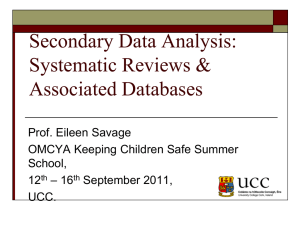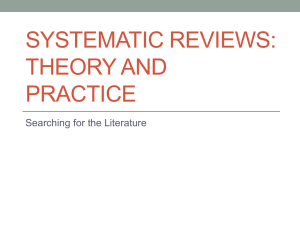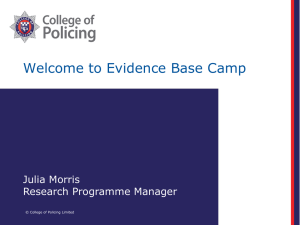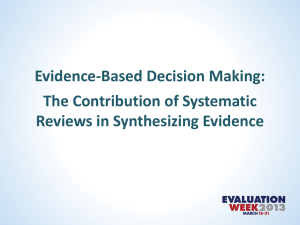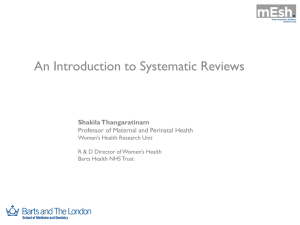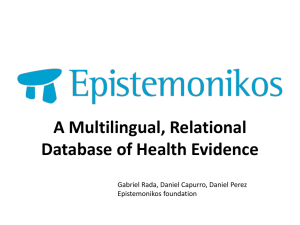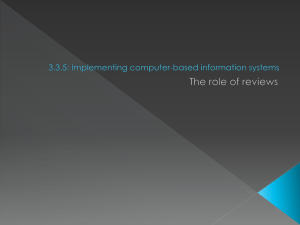ppt
advertisement
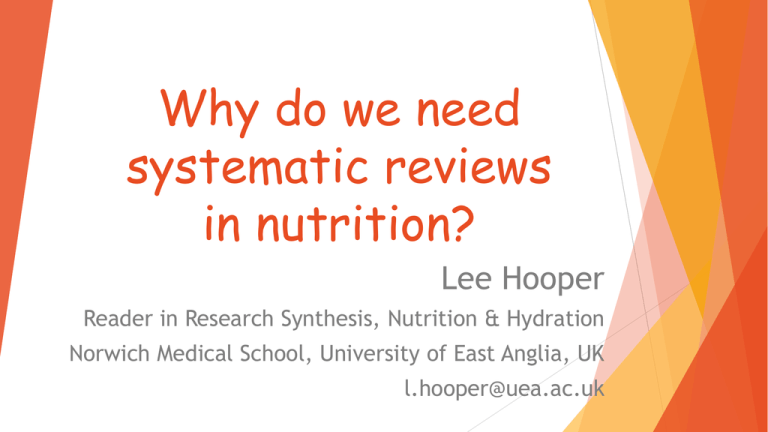
Why do we need systematic reviews in nutrition? Lee Hooper Reader in Research Synthesis, Nutrition & Hydration Norwich Medical School, University of East Anglia, UK l.hooper@uea.ac.uk The venerable history of nutrition & evidence-based care James Lind Dunn PM. James Lind (1716-94) of Edinburgh and the treatment of scurvy. Archives of Disease in Childhood 1997: 76; F64-65. James Lind “On the 20th of May 1747, I selected twelve patients in the scurvy, on board the Salisbury at sea…. Two were ordered each…” * a quart of cyder a day * twenty-five drops of elixir vitriol three times a day * two spoonfuls of vinegar three times a day . . . * a course of sea-water * two oranges and one lemon …every day * an electary recommended by a hospital surgeon “. . the most sudden and visible good effects were perceived from the use of oranges and lemons; one of those who had taken them, being at the end of six days fit for duty . . . The other was the best recovered of any in his condition; and . . . was appointed to attend the rest of the sick.. . .” The venerable history of nutrition & evidence-based care Nagyrápolti Szent-Györgyi Albert 1937: Nobel Prize in Physiology or Medicine "for his discoveries in connection with the biological combustion process with special reference to vitamin C and the catalysis of fumaric acid". The venerable history of nutrition & evidence-based care Archie Cochrane Cochrane AL. Sickness in Salonica: my first, worst, and most successful clinical trial. BMJ 1984:289;1726-7. The diet was minimal-breakfast: unsweetened "ersatz" coffee; midday: a bowl of vegetable soup; evening: two slices of plain breadin all, about 400 to 500 calories. We were always hungry. Cochrane AL. Sickness in Salonica: my first, worst, and most successful clinical trial. BMJ 1984:289;1726-7. 20,000 prisoners over 6 months - outbreaks of typhoid, diphtheria, infections, jaundice, sand-fly fever and oedema – and almost no medicines Cochrane AL. Effectiveness and Efficiency 1972, London: Nuffield Provincial Hospitals Trust. “On reflection, it was not a good trial. I was testing the wrong hypothesis. The oedema was not wet beri-beri. Furthermore, the numbers were too small, the time too short, and the outcome measurements poor. Yet the treatment worked. I still do not know why. I imagine that the simplest explanation is that the small amount of protein in the yeast raised the plasma proteins sufficiently to correct fluid balance.” Cochrane AL. Sickness in Salonica: my first, worst, and most successful clinical trial. BMJ 1984:289;1726-7. Why do we need systematic reviews in nutrition? Remarkable ability for humans to get better, regardless of medical treatment And to get better despite dreadful nutrition So to see effects compared to control we need large numbers of people So why do we need systematic reviews in nutrition? Systematic reviews were not needed to assess effects of citrus fruit on scurvy or of yeast on oedema above the knee. We need them because when we study nutrition these days in societies with a background of reasonably good nutrition we are usually looking for small effects We can only see these small effects when we study large numbers of people Lohner S, Kullenberg D, Antes G, Decsi T, Meerpohl JJ. 2014 Nutrition Reviews. Scale re saturated fat RCTs Forest plot assessing effect of a diet low in saturated fats compared to a usual diet on cardiovascular events, in RCTs of at least 2 years duration Systematic reviews can show us when interventions work differently in different studies – so that we can explore why this may be Lohner S, Kullenberg D, Antes G, Decsi T, Meerpohl JJ. 2014 Nutrition Reviews. Systematic reviews can show us when interventions work differently in different studies – so that we can explore why this may be Subgrouping by degree of reduction in saturated fats Forest plot assessing effect of a diet low in saturated fats compared to a usual diet on cardiovascular events, in RCTs of at least 2 years duration Systematic reviews can show us when interventions work differently in different studies – so that we can explore why this may be Sometimes this can relate to study validity Why do we need systematic reviews in nutrition? Systematic reviews allow us to understand when interventions work, and when they do not (using heterogeneity of included studies) May be due to differences in dose, type or mode of intervention, duration, participants or setting We can use systematic reviews to explore a variety of questions: Efficacy of interventions We can use systematic reviews to explore a variety of questions: Efficacy of interventions Nutritional status in different populations We can use systematic reviews to explore a variety of questions: Efficacy of interventions Nutritional status in different populations Relationships between intake and status We can use systematic reviews to explore a variety of questions: Efficacy of interventions Nutritional status in different populations Relationships between intake and status Testing methods of assessment of nutrient status Why do we need systematic reviews in nutrition? Systematic reviews allow us to address a variety of types of question important to nutrition not only questions of efficacy So why do we need systematic reviews in nutrition? They allow us to re-examine our understanding of nutrition Some tennets of nutrition we take as established – but when we re-examine the evidence in the context of a systematic review it may not be so clear-cut They allow us to check what we do know, and see where there are gaps to fill Why do we need systematic reviews in nutrition? Systematic Are reviews (done well): high quality publications Are relatively inexpensive Often challenge perceived wisdom Why do we need systematic reviews in nutrition? Systematic Feed reviews (done well): into guidance Locally, nationally, internationally This is a way that our research can have real impact on health and wellbeing Why are systematic reviews in nutrition difficult? Where nutritional factors are thought to have small effects over many years (for example, dietary fats or fruit and vegetables on cardiovascular disease) Randomised controlled trials to show effectiveness need to be very large and over long periods of time Or we need to trust to surrogate outcomes Or we need to review cohort studies (but in observational studies confounding is a serious risk) Or use eg Mendelian randomisation The thorny case of Folic acid, systematic reviews and cardiovascular disease… Folic acid - Homocysteine Clarke 2010 SR of RCTs + Cardiovascular disease HSC 2002 SR of observational studies Additionally, systematic review of Mendelian randomisation studies - those with constitutional raised homocysteine are at higher risk of cardiovascular disease – the homocysteine – cardiovascular disease relationship is causal (Wald 2011) So supplementation with folic acid should reduce homocysteine and reduce the risk of cardiovascular disease The thorny case of Folic acid, systematic reviews and cardiovascular disease… Folic acid - Homocysteine Clarke 2010 SR of RCTs + Cardiovascular disease HSC 2002 SR of observational studies x BUT SR of RCTs of folate supplementation found no effect on CVD or any other outcome, and no dose or duration effects (Clarke 2010) So are we being misled about homocysteine being in the causative pathway? Should you or I be taking folic acid to lower our CVD risk? Summary….Why do we need systematic reviews in nutrition? Systematic Are reviews (done well): cost effective Can answer important questions and challenge assumptions Have an impact on health and wellbeing
